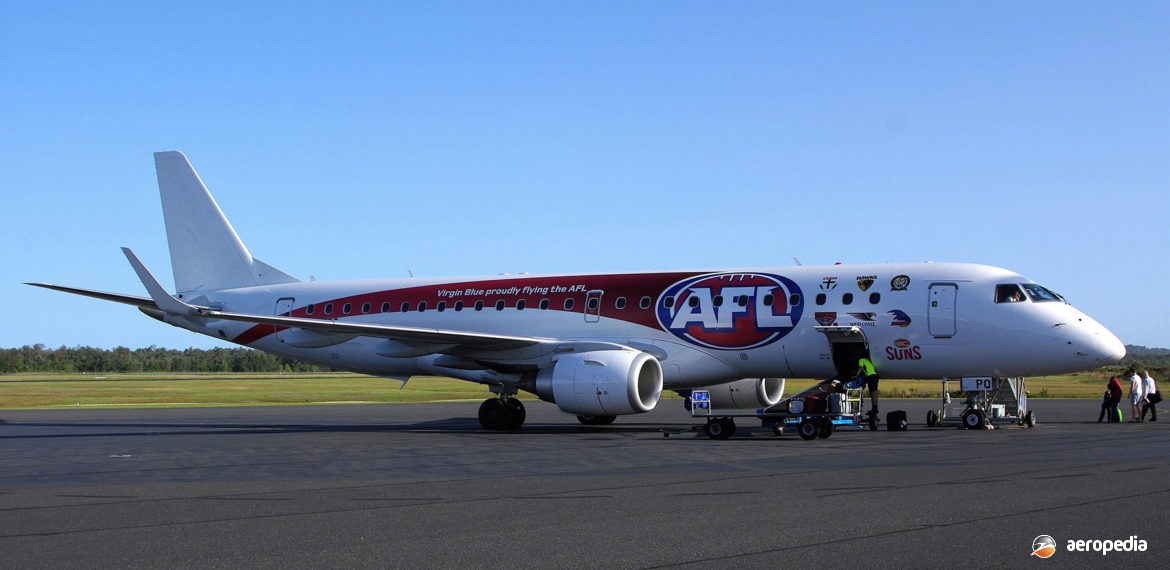Photograph:
Embraer ERJ-190-100IGW VH-ZPQ (c/n 19000412) ‘Main Beach’ at Coffs Harbour, NSW in September 2011 (David C Eyre)
Country of origin:
Brazil
Description:
Commercial airliner
Power Plant:
Two 18,500 lbst General Electric CF34-10E turbofans
Specifications:
- Wingspan: 28.72 m (94 ft 3 in)
- Length: 36.24 m (118 ft 11 in)
- Height: 10.28 m (33 ft 9 in)
- Max cruising speed Mach: 0.82 / 890 km/h (553 mph)
- Range [standard]: 3,334 km (2,072 miles)
History:
Along with the Embraer Models 170, 175, and 195, the Model 190 was one of a new range of airliners produced in Brazil for the world’s markets. The series was launched in February 1999, the first flight of the Model 190 being made in March 2004, followed by the Model 195 in December that year.
The Model 190 was 6.25 m (8 ft 5in) longer and seated 98 passengers, the Model 195 being further stretched by 2.41 m (7 ft 11 in) and seating 108 passengers. All variants were available in standard form or for long-range and all featured engines from the General Electric CF34 series of turbofans.
All aircraft had an all-digital cockpit, being of lightweight modular architecture with a Honeywell Primus Epic electronic flight and information system with liquid crystal colour displays. Flight controls were fly-by-wire. The engines and engine nacelles were supplied by General Electric and had a Full Authority Digital Engine Control system (FADEC) with a fully redundant, computerised management system which optimised engine performance at each phase of the flight to reduce fuel consumption and maintenance costs. All models had forward and aft doors, two on each side, to allow rapid boarding and deplaning, thus allowing for quick turn-arounds. The larger wing of the Model 190 gave more lift and thus the composite flaps were slightly different, with only the inboard section double-slotted. The outboard section was single-slotted and supported by two stations, whilst the inboard section had an additional support at mid-span. Early testing of the series indicated the Model 190 required a larger horizontal stabiliser.
The fuselage was made in seven major segments compared with five on the Model 170. The Embraer-built nose section was common, as was the centre fuselage built by Latecoere, this having a built-in cargo compartment door. Latecoere built the rear fuselage section and the forward plugs were built by Embraer. Hamilton Sundstrand provided the APS2300 auxiliary power unit. The engines were the General Electric CF-34 designed to provide 18,500 lbst to 20,000 lbst for aircraft being developed in the 90 to 110-seat passenger market. First Model 195 was expected to be completed in 2006.
One of the first customers for the Model 190 was JetBlue in the United States, these aircraft having 25 rows of leather seats, each with 36 channels of television and more than 100 satellite radio channels. JetBlue ordered 100 aircraft with deliveries commencing from September 2005.
In October 2006 Virgin Blue in Australia announced it had ordered a fleet of Model 170s and 11 Model 190s and, shortly thereafter, indicated it had exercised options to increase the number to 14, with deliveries to commence late in 2007, these aircraft to have a capacity of 104 passengers in a single class.
First aircraft for Virgin, a Model 170, became VH-ZPA in February 2008; and the first Model 190 was a 190-100IGW which became VH-ZPE (c/n 19000187) in July 2008. Further 190s were imported to Australia for Virgin.
By mid 2007 Embraer had received orders for 655 aircraft in its E-Jet range, and was increasing output from eight to 14 aircraft per month in 2008.
Two Embraer 190-100LRs were operated by SkyAirWorld in Queensland until that airline closed operations and the two aircraft, VH-SXK (c/n 19000154 – ex PT-SAJ) and VH-SXO (c/n 19000231 – ex PT-SIC), were exported to Portugal.
Cobham Aviation Services in Western Australia won a contract extension with Chevron, a resource company, in mid 2014 to fly crews and at that time added a Model 190-100LR to its fleet. This aircraft (c/n 19000404 – ex D-AEMG, PT-TYX) had formerly operated with Augsburg Airways in Germany, becoming VH-NJA when it entered service on the Perth to Barrow Island route. It was operated on a contract with petroleum company Chevron for its Gorgon project off north-western Western Australia. In February 2018 Cobham sold its aircraft, the machine being flown to Warsaw in Poland where it became G-LCYZ.
In recent years Virgin Australia commenced to replace its Model 190s, the last of its fleet of 18 being exported by mid 2020 during the economic shutdown due to the coronavirus pandemic. The airline had announced in mid 2016 that it was rationalising its fleet to help cut costs. Last flight of a Virgin Australia Model 190 was VH-ZPH from Newcastle to Brisbane in February 2018.
In January 2020 Air Kiribati obtained its first E190E-2 model at Wellbank Airport near Toowoomba, QLD, the airline receiving a second aircraft later in the year. The first aircraft became VH-IKJ (c/n 190-20029) owned by the Republic of Kiribati and operated by Pioneer Australia Pty Ltd of Condell Park, NSW. The aircraft operate from Australia to Tarawa, Kiribati and Nauru, the routes having formerly been operated by Air Nauru aircraft.
In mid 2020 Brisbane, QLD based Allliance Airlines obtained 14 E190s from Azorra Aviation in the United States, the aircraft previously having been operated in Panama by Copa Airlines. Each had an average age of ten years. Part of the purchase included six spare General Electric CF34 engines, an option to obtain a further five E190s, a full flight simulator and related training equipment. Alliance Airline at that time had a fleet of 47 Fokker airliners and the E190s will service the company’s routes, seating between 98 and 114 passengers. The first E190 was received in September 2020 and the type was expected to enter service by February 2021.

